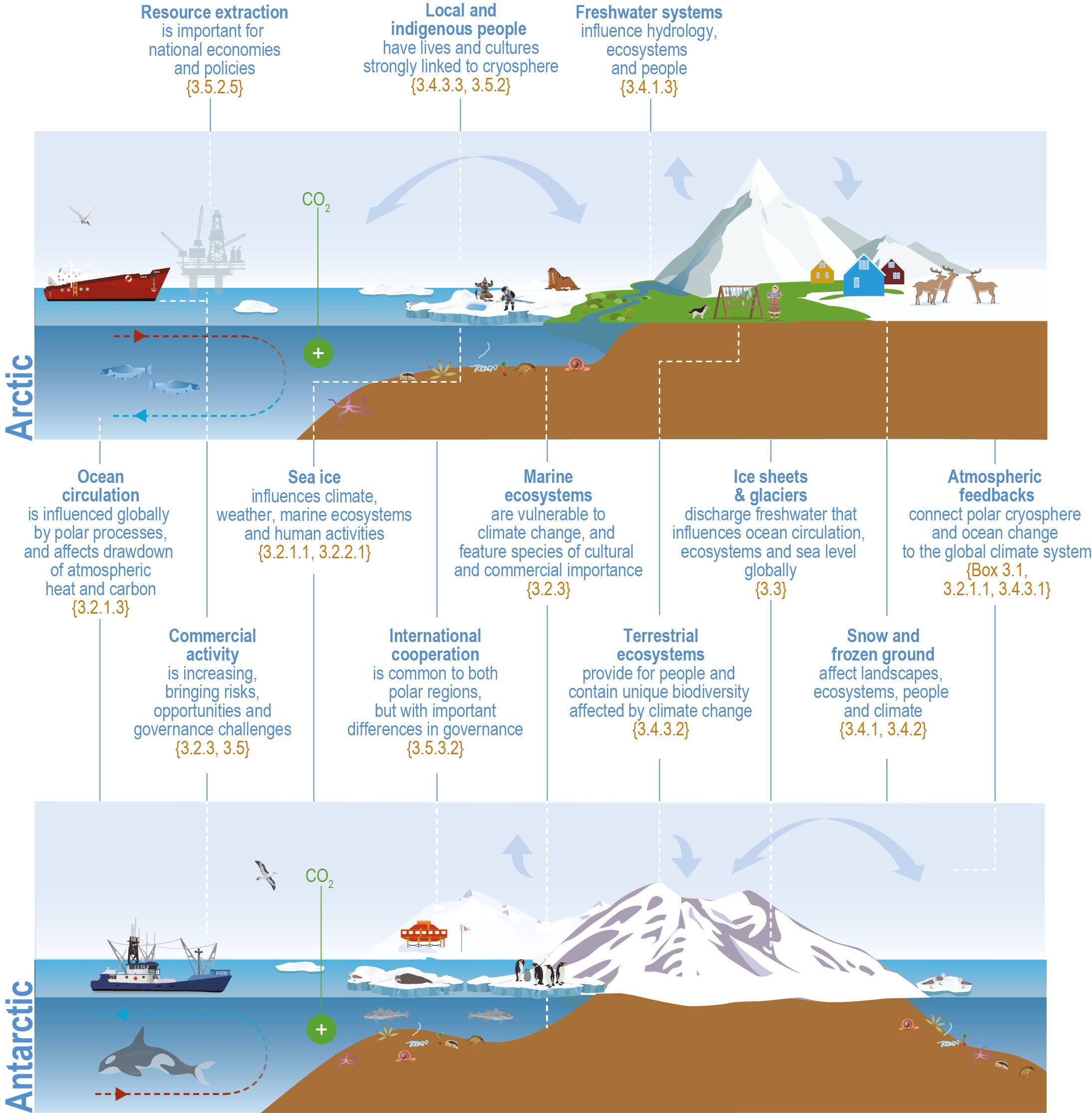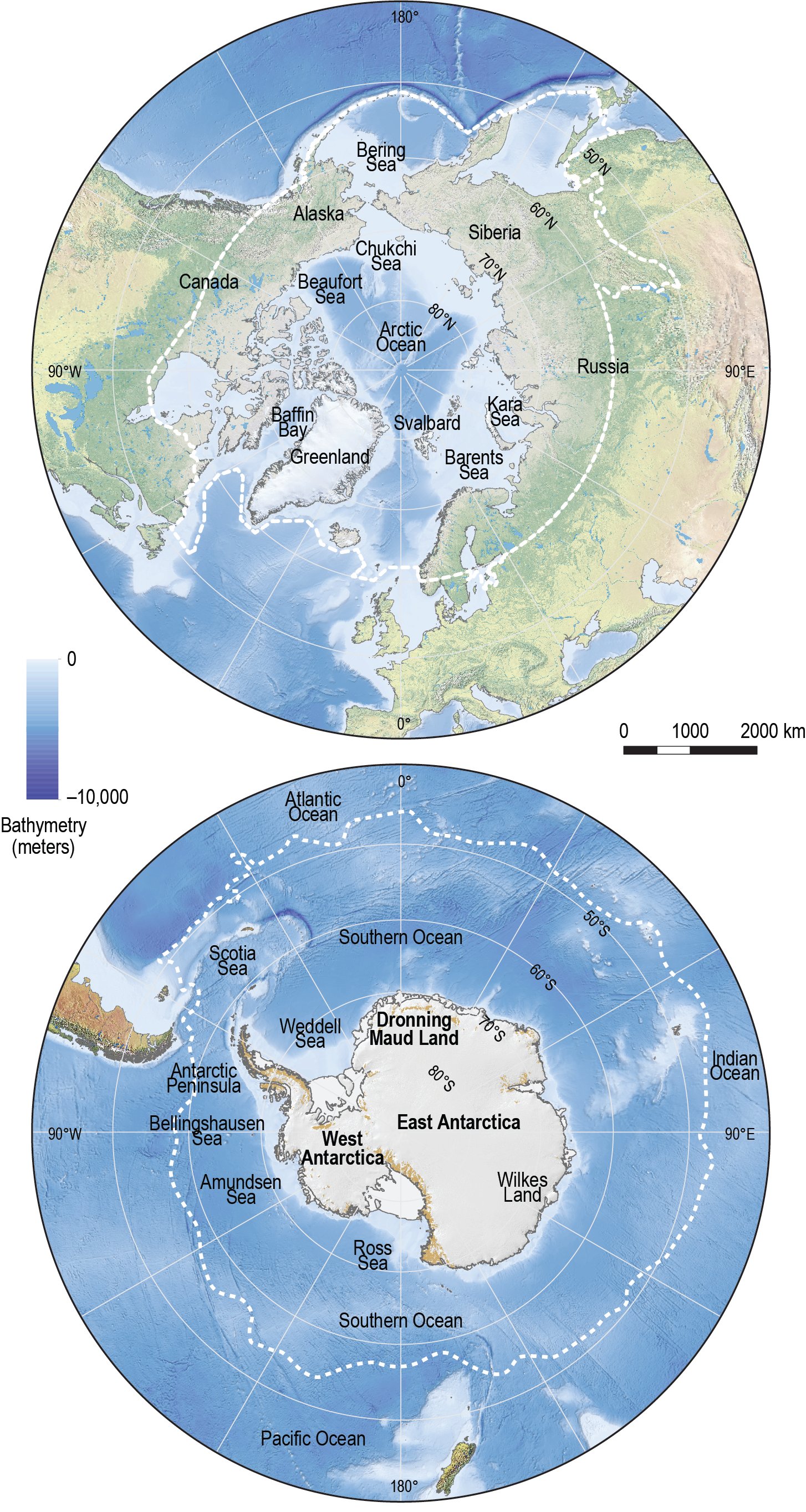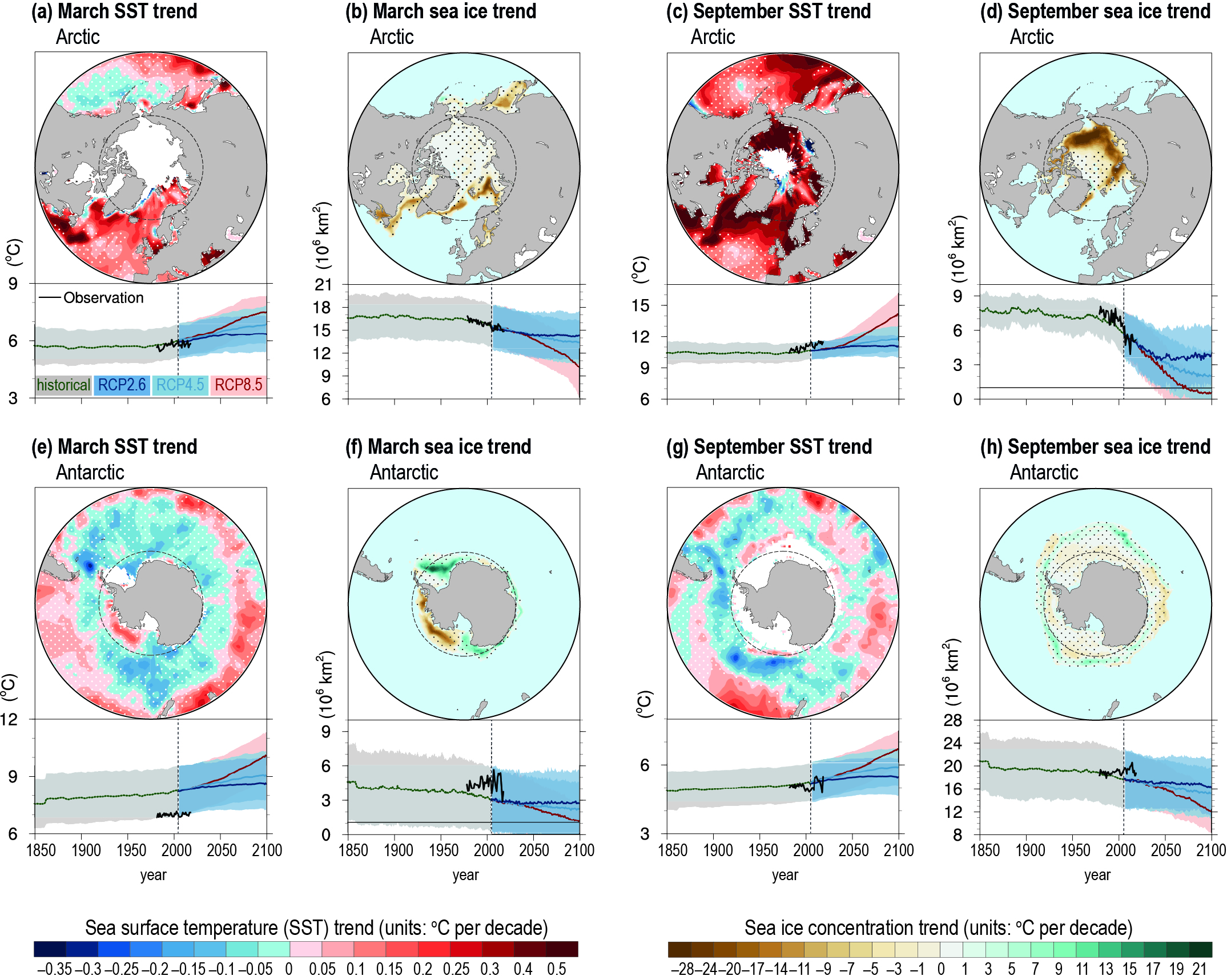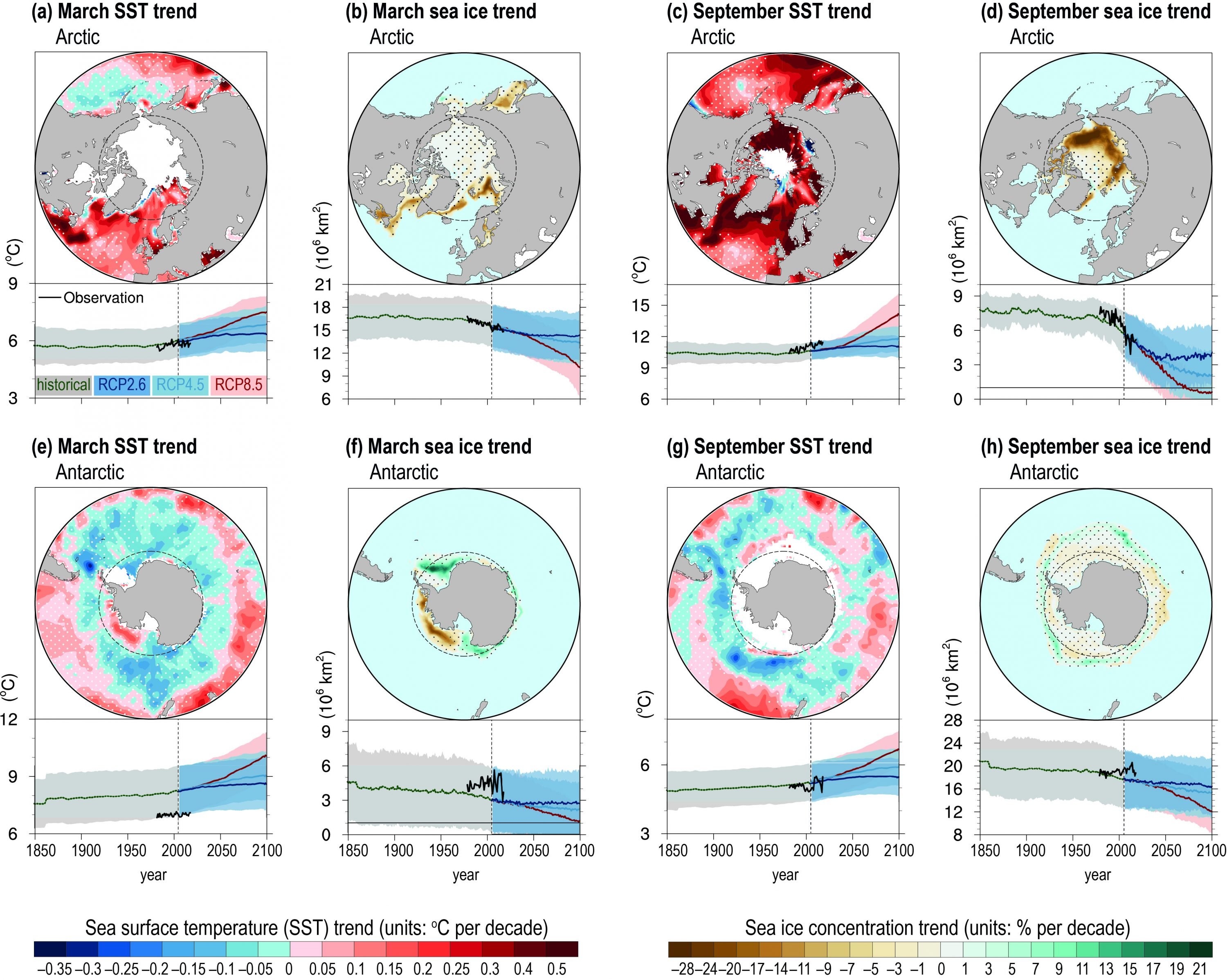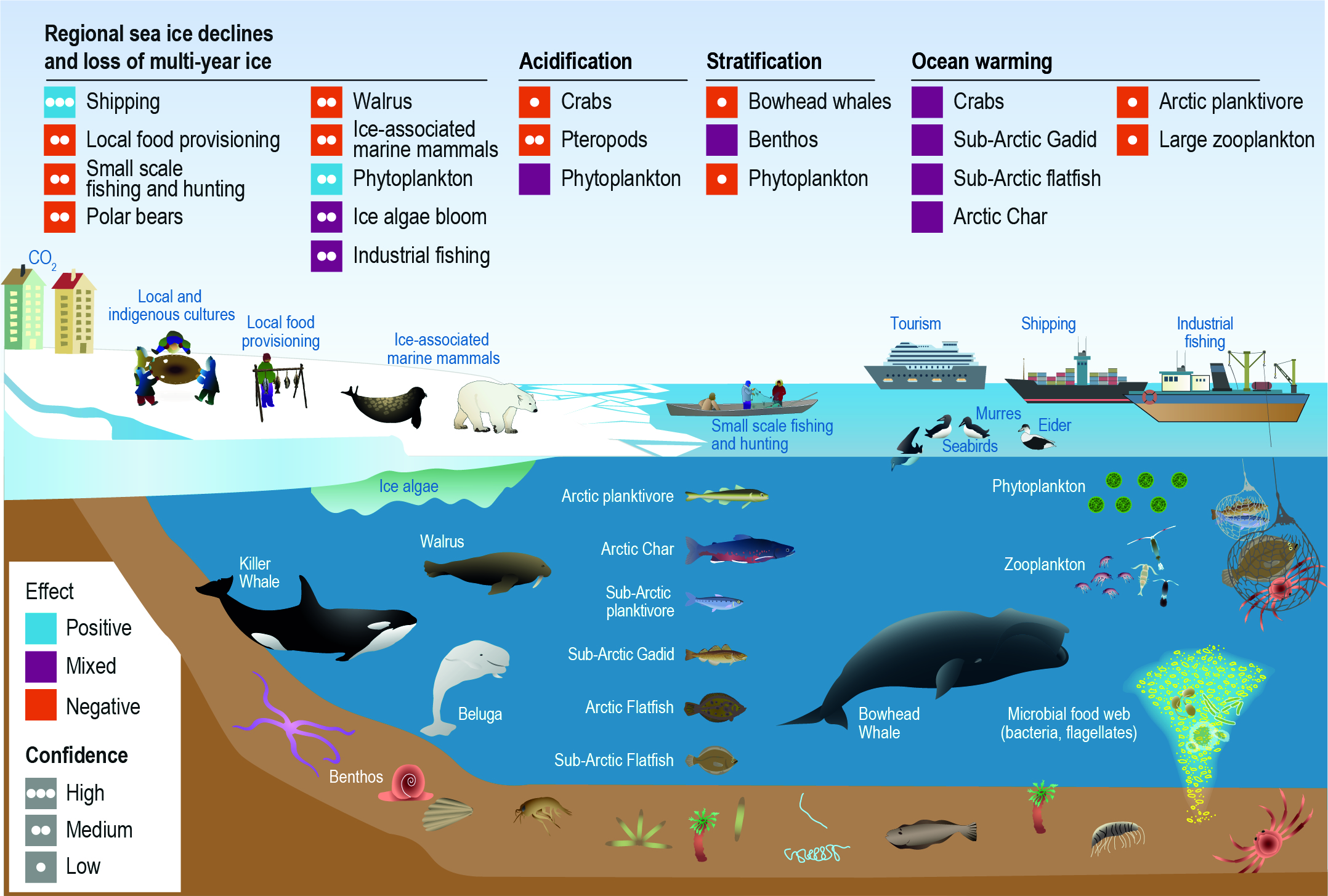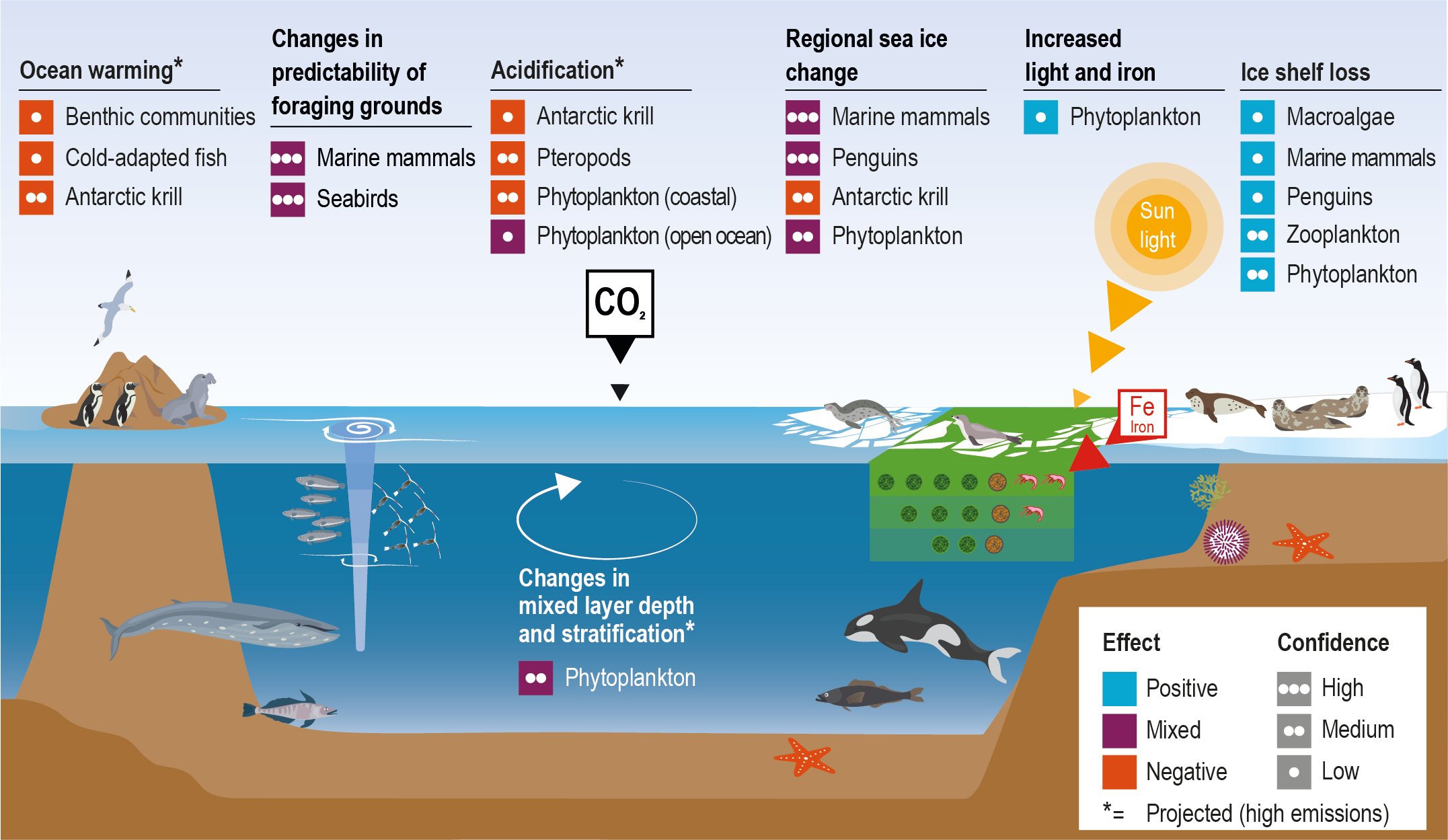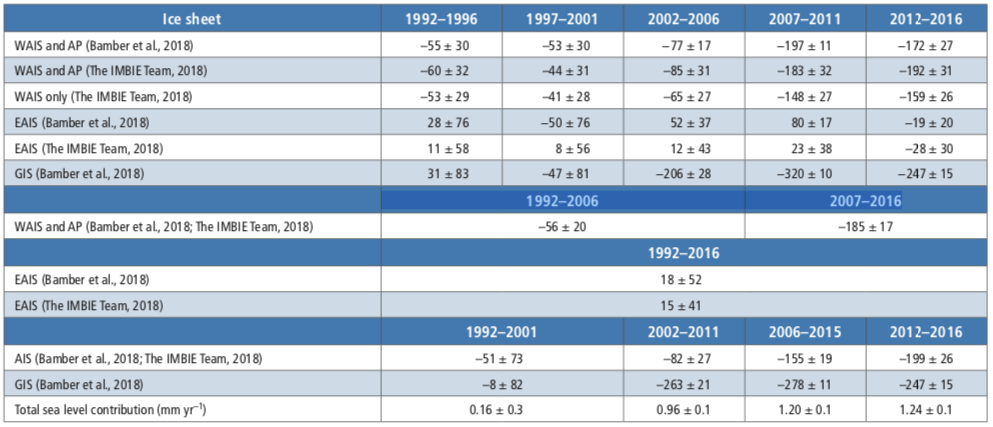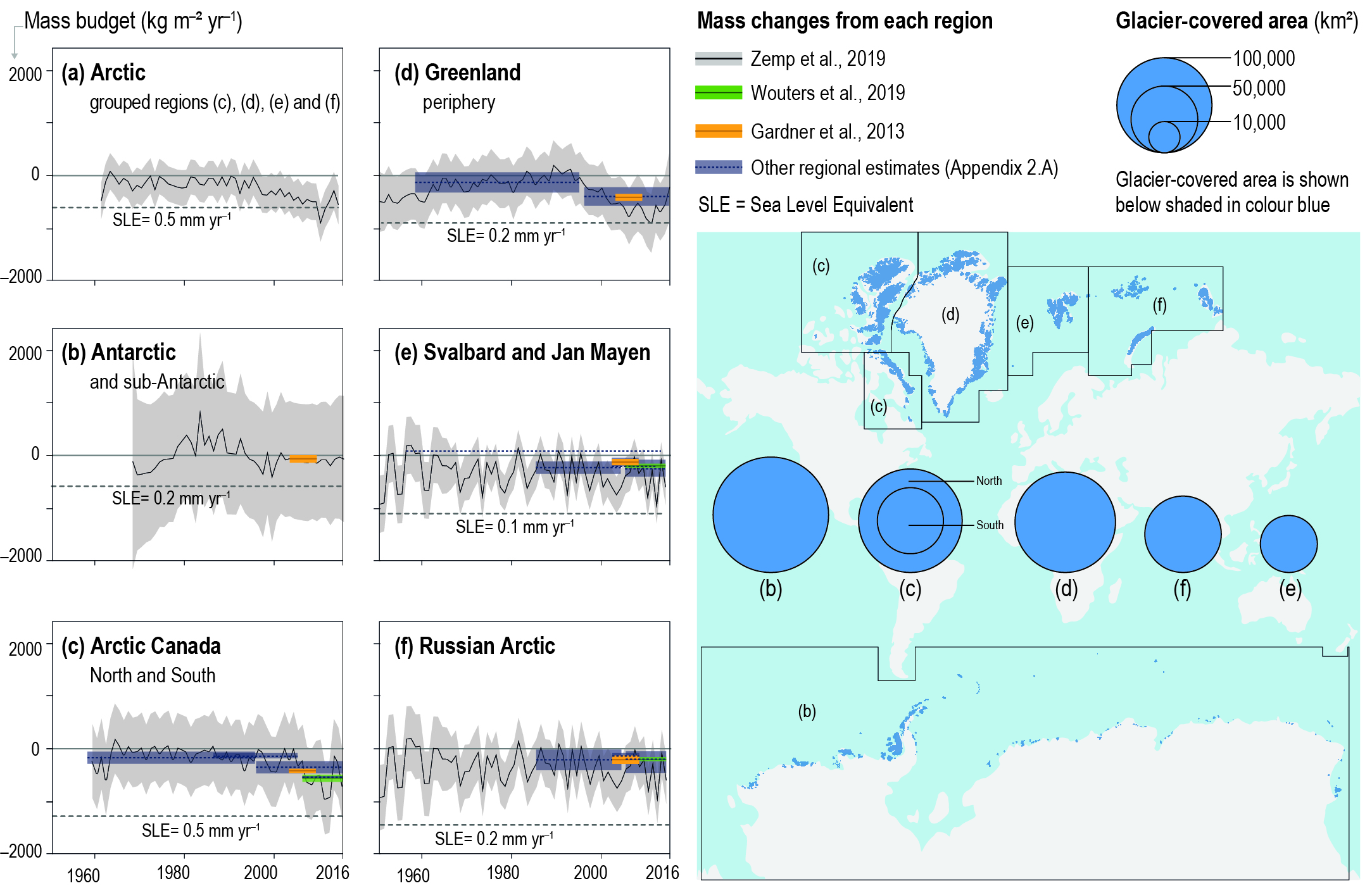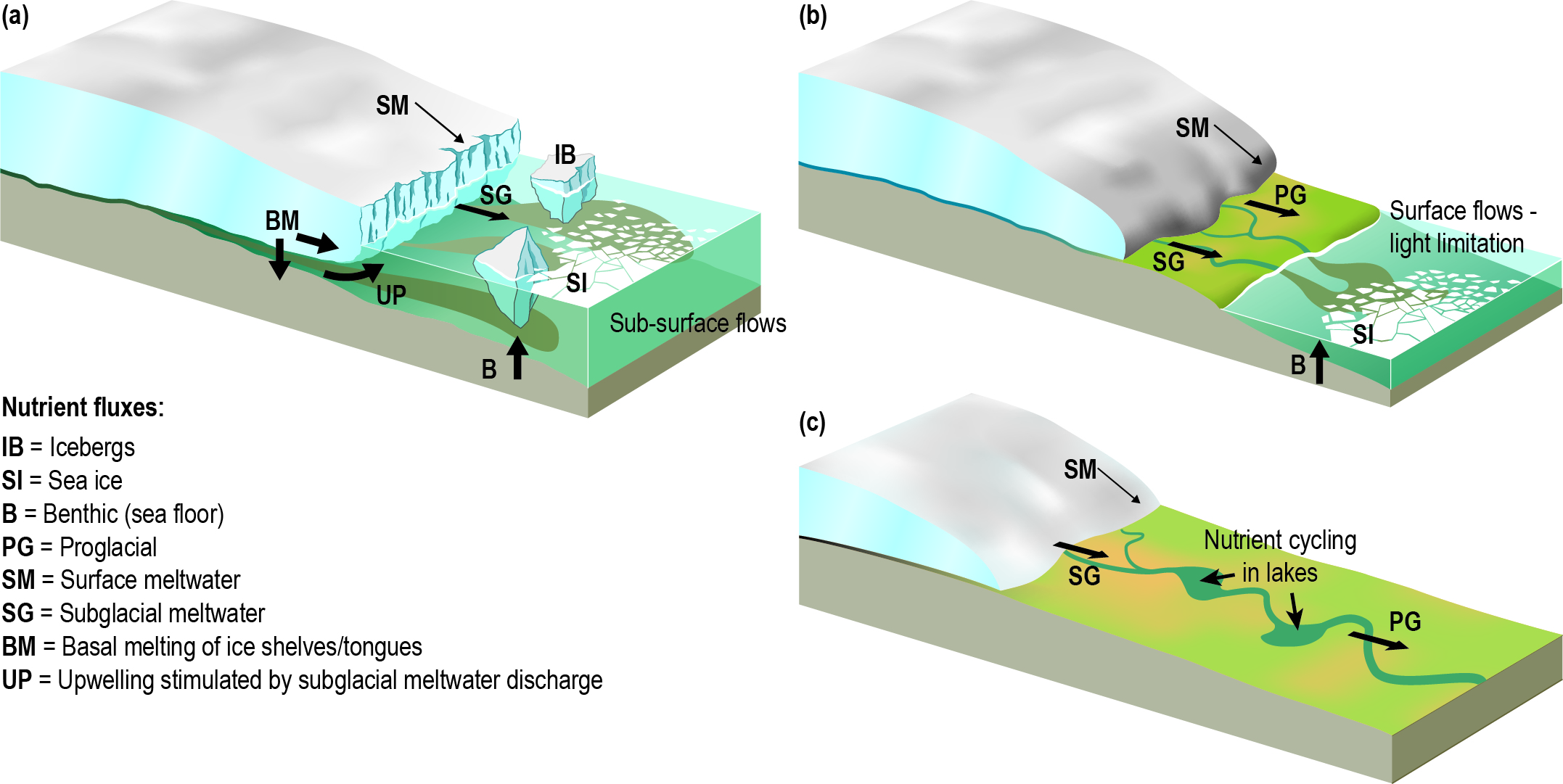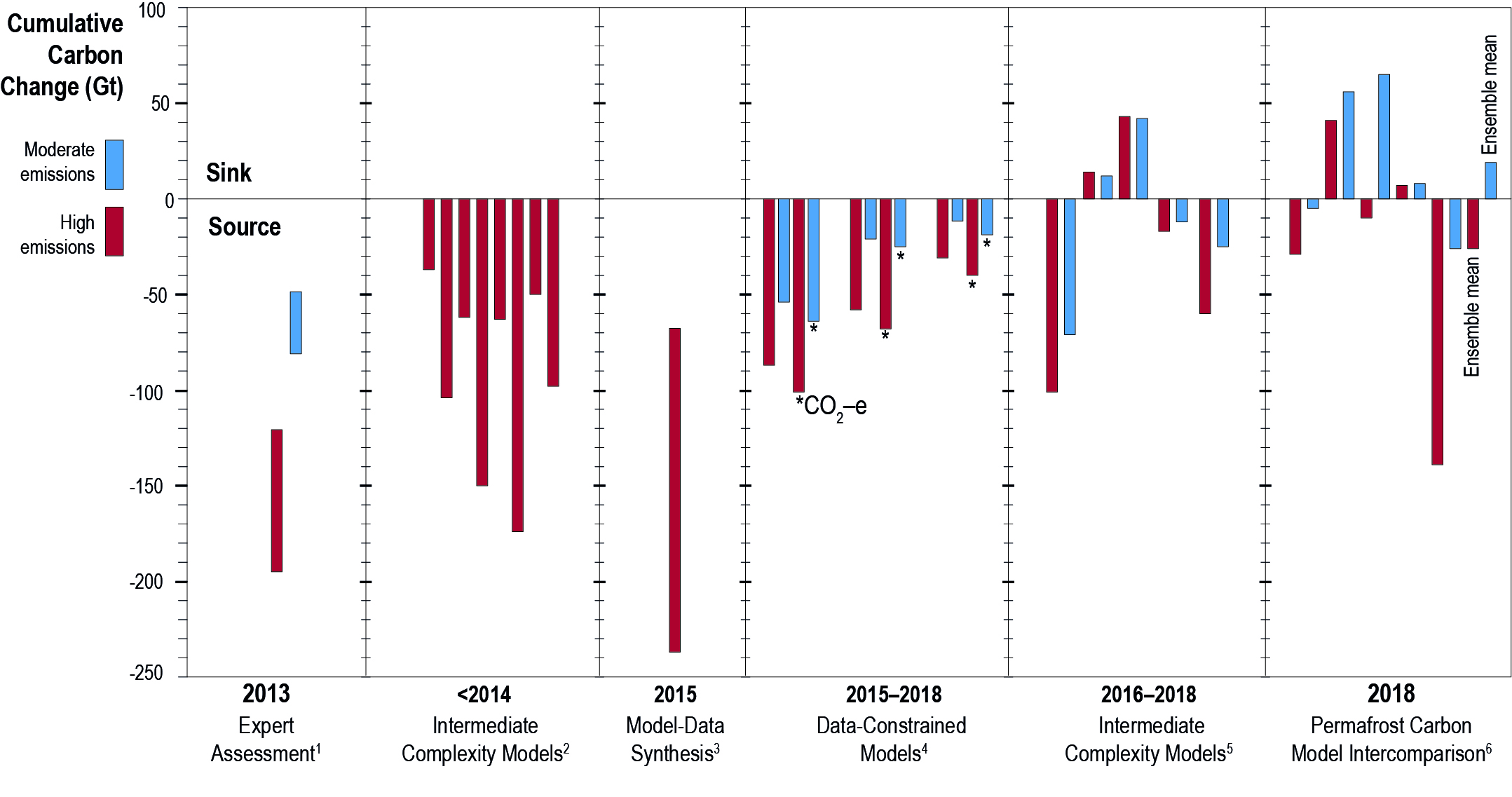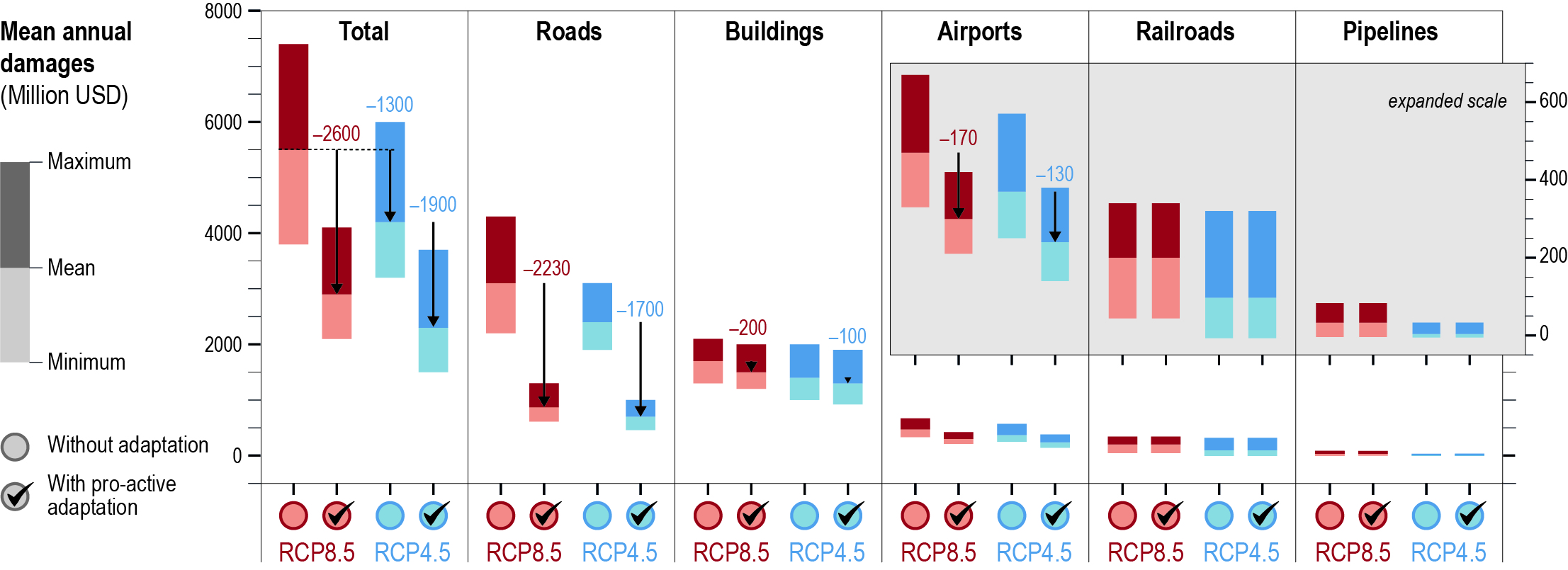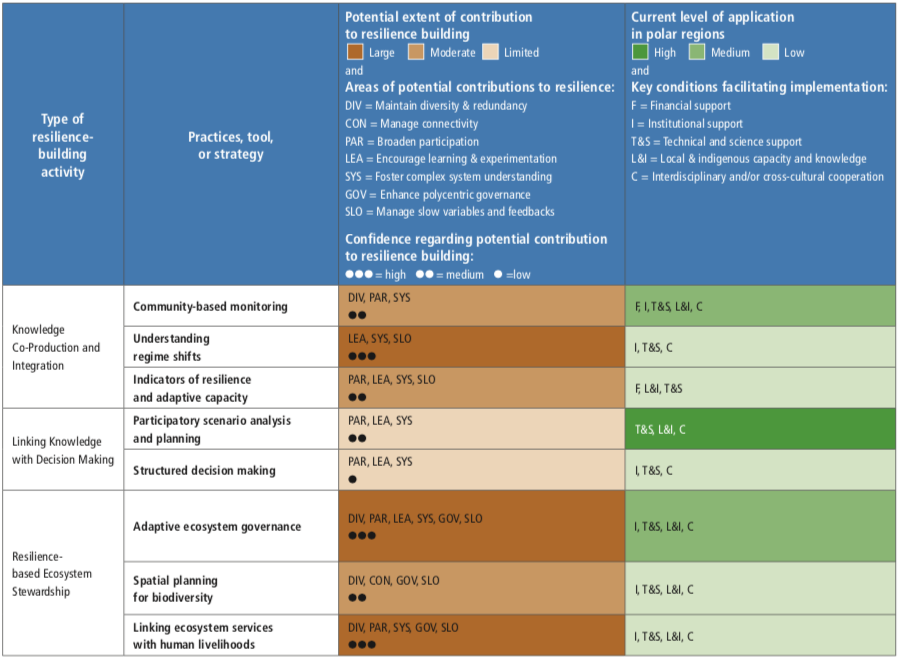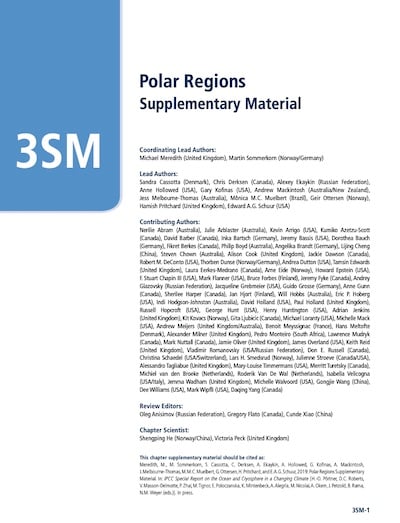ES
Executive Summary
This chapter assesses the state of physical, biological and social knowledge concerning the Arctic and Antarctic ocean and cryosphere, how they are affected by climate change, and how they will evolve in future. Concurrently, it assesses the local, regional and global consequences and impacts of individual and interacting polar system changes, and it assesses response options to reduce risk and build resilience in the polar regions. Key findings are:
The polar regions are losing ice, and their oceans are changing rapidly. The consequences of this polar transition extend to the whole planet, and are affecting people in multiple ways
Arctic surface air temperature has likely1 increased by more than double the global average over the last two decades, with feedbacks from loss of sea ice and snow cover contributing to the amplified warming. For each of the five years since the IPCC 5th Asesssment Report (AR5) (2014–2018), Arctic annual surface air temperature exceeded that of any year since 1900. During the winters (January to March) of 2016 and 2018, surface temperatures in the central Arctic were 6°C above the 1981–2010 average, contributing to unprecedented regional sea ice absence. These trends and extremes provide medium evidence 2 with high agreement of the contemporary coupled atmosphere-cryosphere system moving well outside the 20th century envelope. {Box 3.1; 3.2.1.1}
The Arctic and Southern Oceans are continuing to remove carbon dioxide from the atmosphere and to acidify (high confidence). There is medium confidence that the amount of CO2 drawn into the Southern Ocean from the atmosphere has experienced significant decadal variations since the 1980s. Rates of calcification (by which marine organisms form hard skeletons and shells) declined in the Southern Ocean by 3.9 ± 1.3% between 1998 and 2014. In the Arctic Ocean, the area corrosive to organisms that form shells and skeletons using the mineral aragonite expanded between the 1990s and 2010, with instances of extreme aragonite undersaturation. {3.2.1.2.4}
Both polar oceans have continued to warm in recent years, with the Southern Ocean being disproportionately and increasingly important in global ocean heat increase (high confidence). Over large sectors of the seasonally ice-free Arctic, summer upper mixed layer temperatures increased at around 0.5°C per decade during 1982–2017, primarily associated with increased absorbed solar radiation accompanying sea ice loss, and the inflow of ocean heat from lower latitude increased since the 2000s (high confidence). During 1970–2017, the Southern Ocean south of 30°S accounted for 35–43% of the global ocean heat gain in the upper 2000 m (high confidence), despite occupying ~25% of the global ocean area. In recent years (2005–2017), the Southern Ocean was responsible for an increased proportion of the global ocean heat increase (45–62%) (high confidence). {3.2.1.2.1}
Climate-induced changes in seasonal sea ice extent and thickness and ocean stratification are altering marine primary production (high confidence), with impacts on ecosystems (medium confidence). Changes in the timing, duration and intensity of primary production have occurred in both polar oceans, with marked regional or local variability (high confidence). In the Antarctic, such changes have been associated with locally-rapid environmental change, including retreating glaciers and sea ice change (medium confidence). In the Arctic, changes in primary production have affected regional species composition, spatial distribution, and abundance of many marine species, impacting ecosystem structure (medium confidence). {3.2.1; 3.2.3, 3.2.4}
In both polar regions, climate-induced changes in ocean and sea ice, together with human introduction of non-native species, have expanded the range of temperate species and contracted the range of polar fish and ice-associated species (high confidence). Commercially and ecologically important fish stocks like Atlantic cod, haddock and mackerel have expanded their spatial distributions northwards many hundreds of kilometres, and increased their abundance. In some Arctic areas, such expansions have affected the whole fish community, leading to higher competition and predation on smaller sized fish species, while some commercial fisheries have benefited. There has been a southward shift in the distribution of Antarctic krill in the South Atlantic, the main area for the krill fishery (medium confidence). These changes are altering biodiversity in polar marine ecosystems (medium confidence) {3.2.3; Box 3.4}.
Arctic sea ice extent continues to decline in all months of the year (very high confidence); the strongest reductions in September (very likely –12.8 ± 2.3% per decade; 1979–2018) are unprecedented in at least 1000 years (medium confidence). Arctic sea ice has thinned, concurrent with a shift to younger ice: since 1979, the areal proportion of thick ice at least 5 years old has declined by approximately 90% (very high confidence). Approximately half the observed sea ice loss is attributable to increased atmospheric greenhouse gas concentrations (medium confidence). Changes in Arctic sea ice have potential to influence mid-latitude weather on timescales of weeks to months (low to medium confidence). {3.2.1.1; Box 3.2}
It is very likely that Antarctic sea ice cover exhibits no significant trend over the period of satellite observations (1979–2018). While the drivers of historical decadal variability are known with medium confidence, there is currently limited evidence and low agreement concerning causes of the strong recent decrease (2016–2018), and low confidence in the ability of current-generation climate models to reproduce and explain the observations. {3.2.1.1}
Shipping activity during the Arctic summer increased over the past two decades in regions for which there is information, concurrent with reductions in sea ice extent (high confidence). Transit times across the Northern Sea Route have shortened due to lighter ice conditions, and while long-term, pan-Arctic datasets are incomplete, the distance travelled by ships in Arctic Canada nearly tripled during 1990–2015 (high confidence). Greater levels of Arctic ship-based transportation and tourism have socioeconomic and political implications for global trade, northern nations, and economies linked to traditional shipping corridors; they will also exacerbate region specific risks for marine ecosystems and coastal communities if further action to develop and adequately implement regulations does not keep pace with increased shipping (high confidence). {3.2.1.1; 3.2.4.2; 3.2.4.3; 3.4.3.3.2; 3.5.2.7}
Permafrost temperatures have increased to record high levels (very high confidence), but there is medium evidence and low agreement that this warming is currently causing northern permafrost regions to release additional methane and carbon dioxide. During 2007–2016, continuous-zone permafrost temperatures in the Arctic and Antarctic increased by 0.39 ± 0.15°C and 0.37 ± 0.10°C respectively. Arctic and boreal permafrost region soils contain 1460–1600 Gt organic carbon (medium confidence). Changes in permafrost influence global climate through emissions of carbon dioxide and methane released from the microbial breakdown of organic carbon, or the release of trapped methane. {3.4.1; 3.4.3}
Climate-related changes to Arctic hydrology, wildfire and abrupt thaw are occurring (high confidence), with impacts on vegetation and water and food security. Snow and lake ice cover has declined, with June snow extent decreasing 13.4 ± 5.4% per decade (1967–2018) (high confidence). Runoff into the Arctic Ocean increased for Eurasian and North American rivers by 3.3 ± 1.6% and 2.0 ± 1.8% respectively (1976–2017; medium confidence). Area burned and frequency of fires (including extreme fires) are unprecedented over the last 10,000 years (high confidence). There has been an overall greening of the tundra biome, but also browning in some regions of tundra and boreal forest, and changes in the abundance and distribution of animals including reindeer and salmon (high confidence). Together, these impact access to (and food availability within) herding, hunting, fishing, forage and gathering areas, affecting the livelihood, health and cultural identity of residents including Indigenous peoples (high confidence). {3.4.1; 3.4.3; 3.5.2}
Limited knowledge, financial resources, human capital and organisational capacity are constraining adaptation in many human sectors in the Arctic (high confidence). Harvesters of renewable resources are adjusting timing of activities to changes in seasonality and less safe ice travel conditions. Municipalities and industry are addressing infrastructure failures associated with flooding and thawing permafrost, and coastal communities and cooperating agencies are in some cases planning for relocation (high confidence). In spite of these adaptations, many groups are making decisions without adequate knowledge to forecast near- and long-term conditions, and without the funding, skills and institutional support to engage fully in planning processes (high confidence). {3.5.2, 3.5.4, Cross-Chapter Box 9}
It is extremely likely that the rapid ice loss from the Greenland and Antarctic ice sheets during the early 21st century has increased into the near present day, adding to the ice sheet contribution to global sea level rise. From Greenland, the 2012–2016 ice losses (–247 ± 15 Gt yr-1) were similar to those from 2002 to 2011 (–263 ± 21 Gt yr-1) and extremely likely greater than from 1992 to 2001 (–8 ± 82 Gt yr-1). Summer melting of the Greenland Ice Sheet (GIS) has increased since the 1990s (very high confidence) to a level unprecedented over at least the last 350 years, and two-to-fivefold the pre-industrial level (medium confidence). From Antarctica, the 2012–2016 losses (–199 ± 26 Gt yr-1) were extremely likely greater than those from 2002 to 2011 (–82 ± 27 Gt yr-1) and likely greater than from 1992 to 2001 (–51 ± 73 Gt yr-1). Antarctic ice loss is dominated by acceleration, retreat and rapid thinning of major West Antarctic Ice Sheet (WAIS) outlet glaciers (very high confidence), driven by melting of ice shelves by warm ocean waters (high confidence). The combined sea level rise contribution from both ice sheets for 2012–2016 was 1.2 ± 0.1 mm yr-1, a 29% increase on the 2002–2011 contribution and a ~700% increase on the 1992–2001 period. {3.3.1}
Mass loss from Arctic glaciers (–212 ± 29 Gt yr-1) during 2006–2015 contributed to sea level rise at a similar rate (0.6 ± 0.1 mm yr-1) to the GIS (high confidence).
Over the same period in Antarctic and subantarctic regions, glaciers separate from the ice sheets changed mass by –11 ± 108 Gt yr-1 (low confidence). {2.2.3, 3.3.2}
There is limited evidence and high agreement that recent Antarctic Ice Sheet (AIS) mass losses could be irreversible over decades to millennia. Rapid mass loss due to glacier flow acceleration in the Amundsen Sea Embayment (ASE) of West Antarctica and in Wilkes Land, East Antarctica, may indicate the beginning of Marine Ice Sheet Instability (MISI), but observational data are not yet sufficient to determine whether these changes mark the beginning of irreversible retreat. {3.3.1; Cross-Chapter Box 8 in Chapter 3; 4.2.3.1.2}
The polar regions will be profoundly different in future compared with today, and the degree and nature of that difference will depend strongly on the rate and magnitude of global climatic change3. This will challenge adaptation responses regionally and worldwide.
It is very likely that projected Arctic warming will result in continued loss of sea ice and snow on land, and reductions in the mass of glaciers. Important differences in the trajectories of loss emerge from 2050 onwards, depending on mitigation measures taken (high confidence). For stabilised global warming of 1.5°C, an approximately 1% chance of a given September being sea ice free at the end of century is projected; for stabilised warming at a 2°C increase, this rises to 10–35% (high confidence). The potential for reduced (further 5–10%) but stabilised Arctic autumn and spring snow extent by mid-century for Representative Concentration Pathway (RCP)2.6 contrasts with continued loss under RCP8.5 (a further 15–25% reduction to end of century) (high confidence). Projected mass reductions for polar glaciers between 2015 and 2100 range from 16 ± 7% for RCP2.6 to 33 ± 11% for RCP8.5 (medium confidence). {3.2.2; 3.3.2; 3.4.2, Cross-Chapter Box 6 in Chapter 2}
Both polar oceans will be increasingly affected by CO2 uptake, causing conditions corrosive for calcium carbonate shell-producing organisms (high confidence), with associated impacts on marine organisms and ecosystems (medium confidence). It is very likely that both the Southern Ocean and the Arctic Ocean will experience year-round conditions of surface water undersaturation for mineral forms of calcium carbonate by 2100 under RCP8.5; under RCP2.6 the extent of undersaturated waters are reduced markedly. Imperfect representation of local processes and sea ice interaction in global climate models limit the ability to project the response of specific polar areas and the precise timing of undersaturation at seasonal scales. Differences in sensitivity and the scope for adaptation to projected levels of ocean acidification exist across a broad range of marine species groups. {3.2.1; 3.2.2.3; 3.2.3}
Future climate-induced changes in the polar oceans, sea ice, snow and permafrost will drive habitat and biome shifts, with associated changes in the ranges and abundance of ecologically important species (medium confidence). Projected shifts will include further habitat contraction and changes in abundance for polar species, including marine mammals, birds, fish, and Antarctic krill (medium confidence). Projected range expansion of subarctic marine species will increase pressure for high-Arctic species (medium confidence), with regionally variable impacts. Continued loss of Arctic multi-year sea ice will affect ice-related and pelagic primary production (high confidence), with impacts for whole ice-associated, seafloor and open ocean ecosystems. On Arctic land, projections indicate a loss of globally unique biodiversity as some high Arctic species will be outcompeted by more temperate species and very limited refugia exist (medium confidence). Woody shrubs and trees are projected to expand, covering 24–52% of the current tundra region by 2050. {3.2.2.1; 3.2.3; 3.2.3.1; Box 3.4; 3.4.2; 3.4.3}
The projected effects of climate-induced stressors on polar marine ecosystems present risks for commercial and subsistence fisheries with implications for regional economies, cultures and the global supply of fish, shellfish, and Antarctic krill (high confidence). Future impacts for linked human systems depend on the level of mitigation and especially the responsiveness of precautionary management approaches (medium confidence). Polar regions support several of the world’s largest commercial fisheries. Specific impacts on the stocks and economic value in both regions will depend on future climate change and on the strategies employed to manage the effects on stocks and ecosystems (medium confidence). Under high emission scenarios current management strategies of some high-value stocks may not sustain current catch levels in the future (low confidence); this exemplifies the limits to the ability of existing natural resource management frameworks to address ecosystem change. Adaptive management that combines annual measures and within-season provisions informed by assessments of future ecosystem trends reduces the risks of negative climate change impacts on polar fisheries (medium confidence). {3.2.4; 3.5.2; 3.5.4}
Widespread disappearance of Arctic near-surface permafrost is projected to occur this century as a result of warming (very high confidence), with important consequences for global climate. By 2100, near-surface permafrost area will decrease by 2–66% for RCP2.6 and 30–99% for RCP8.5. This is projected to release 10s to 100s of billions of tons (Gt C), up to as much as 240 Gt C, of permafrost carbon as carbon dioxide and methane to the atmosphere with the potential to accelerate climate change. Methane will contribute a small proportion of these additional carbon emissions, on the order of 0.01–0.06 Gt CH4 yr-1, but could contribute 40–70% of the total permafrost-affected radiative forcing because of its higher warming potential. There is medium evidence but with low agreement whether the level and timing of increased plant growth and replenishment of soil will compensate these permafrost carbon losses. {3.4.2; 3.4.3}
Projected permafrost thaw and decrease in snow will affect Arctic hydrology and wildfire, with impacts on vegetation and human infrastructure (medium confidence). About 20% of Arctic land permafrost is vulnerable to abrupt permafrost thaw and ground subsidence, which is expected to increase small lake area by over 50% by 2100 for RCP8.5 (medium confidence). Even as the overall regional water cycle intensifies, including increased precipitation, evapotranspiration, and river discharge to the Arctic Ocean, decreases in snow and permafrost may lead to soil drying (medium confidence). Fire is projected to increase for the rest of this century across most tundra and boreal regions, while interactions between climate and shifting vegetation will influence future fire intensity and frequency (medium confidence). By 2050, 70% of Arctic infrastructure is located in regions at risk from permafrost thaw and subsidence; adaptation measures taken in advance could reduce costs arising from thaw and other climate change related impacts such as increased flooding, precipitation, and freeze-thaw events by half (medium confidence). {3.4.1; 3.4.2; 3.4.3; 3.5.2}.
Response options exist that can ameliorate the impacts of polar change, build resilience and allow time for effective mitigation measures. Institutional barriers presently limit their efficacy.
Responding to climate change in polar regions will be more effective if attention to reducing immediate risks (short-term adaptation) is concurrent with long-term planning that builds resilience to address expected and unexpected impacts (high confidence). Emphasis on short-term adaptation to specific problems will ultimately not succeed in reducing the risks and vulnerabilities to society given the scale, complexity and uncertainty of climate change. Moving toward a dual focus of short- and long-term adaptation involves knowledge co-production, linking knowledge with decision making and implementing ecosystem-based stewardship, which involves the transformation of many existing institutions (high confidence). {3.5.4}
Innovative tools and practices in polar resource management and planning show strong potential in improving society’s capacity to respond to climate change (high confidence). Networks of protected areas, participatory scenario analysis, decision support systems, community-based ecological monitoring that draws on local and indigenous knowledge, and self assessments of community resilience contribute to strategic plans for sustaining biodiversity and limit risk to human livelihoods and wellbeing. Such practices are most effective when linked closely to the policy process. Experimenting, assessing, and continually refining practices while strengthening the links with decision making has the potential to ready society for the expected and unexpected impacts of climate change (high confidence). {3.5.1, 3.5.2, 3.5.4}
Institutional arrangements that provide for strong multiscale linkages with Arctic local communities can benefit from including indigenous knowledge and local knowledge in the formulation of adaptation strategies (high confidence). The tightly coupled relationship of northern local communities and their environment provide an opportunity to better understand climate change and its effects, support adaptation and limit unintended consequences. Enabling conditions for the involvement of local communities in climate adaptation planning include investments in human capital, engagement processes for knowledge co-production and systems of adaptive governance. {3.5.3}
The capacity of governance systems in polar regions to respond to climate change has strengthened recently, but the development of these systems is not sufficiently rapid or robust to address the challenges and risks to societies posed by projected changes (high confidence). Human responses to climate change in the polar regions occur in a fragmented governance landscape. Climate change, new polar interests from outside the regions, and an increasingly active role played by informal organisations are compelling stronger coordination and integration between different levels and sectors of governance. The governance landscape is currently not sufficiently equipped to address cascading risks and uncertainty in an integrated and precautionary way within existing legal and policy frameworks (high confidence). {3.5.3, 3.5.4}
